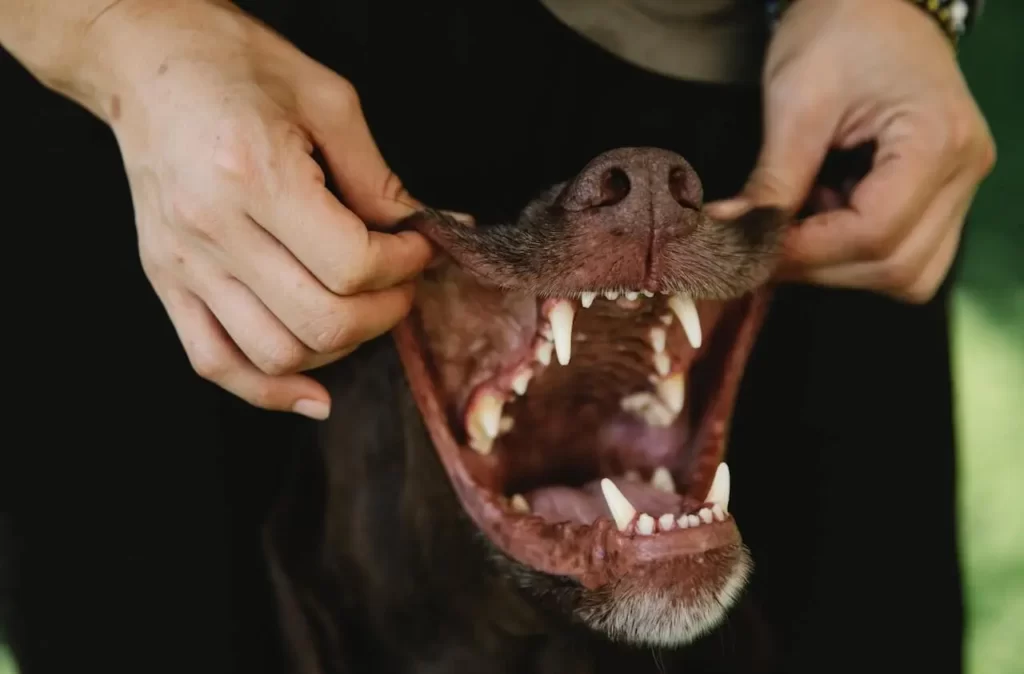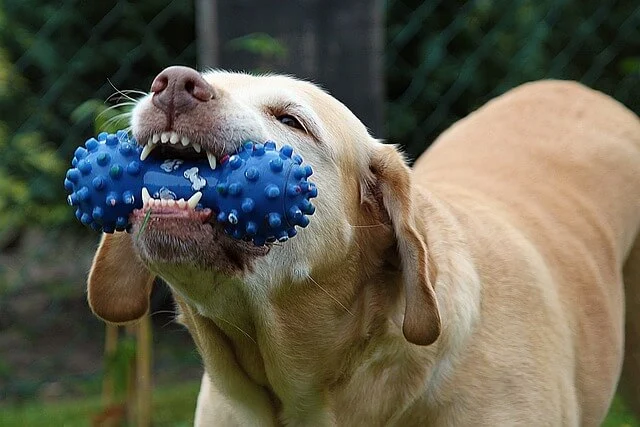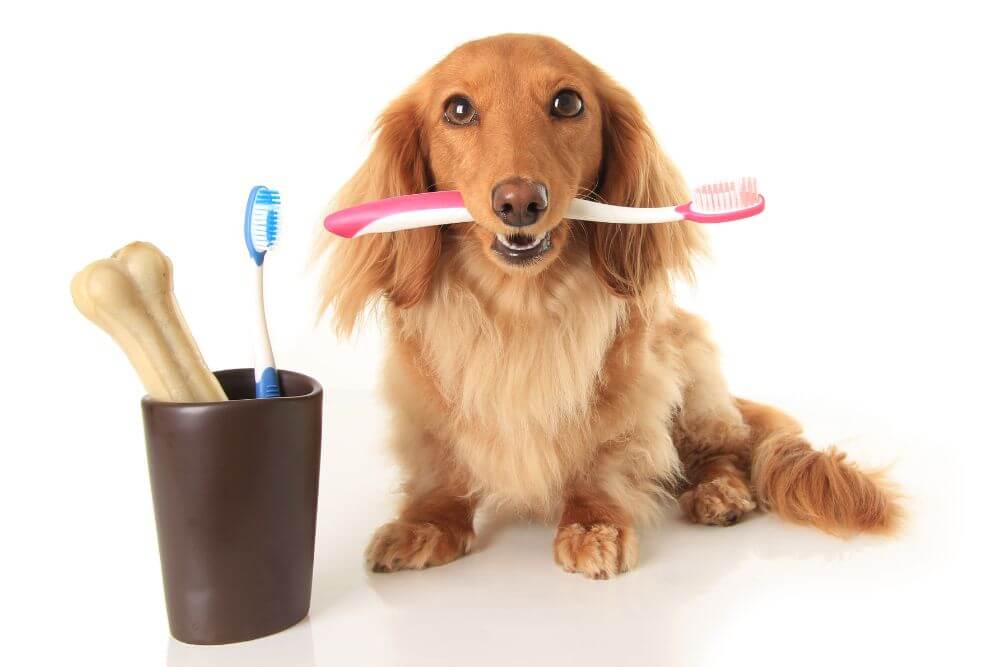Good dental care is vital for the overall health and well-being of our furry friends. Regular dog dental cleaning is essential to prevent various problems like plaque buildup, tartar accumulation, and gum diseases and maintain your dog’s oral hygiene.
In this comprehensive guide, we will cover various aspects of dog dental cleaning, including techniques for brushing dog teeth, alternative cleaning methods, professional cleaning, potential complications, costs involved, aftercare, and problems that can arise if dog teeth cleaning is neglected. Let’s dive in and explore the best practices for keeping your dog’s teeth clean and healthy.
How to Brush Dog Teeth?
Brushing your dog’s teeth is the most important part of their dental care routine. Here are some essential steps to follow when brushing your dog’s teeth:
Choose the Right Toothbrush and Dog Toothpaste
Select a toothbrush with soft bristles and toothpaste specially formulated for dogs. Avoid using human toothpaste, as it can be harmful to dogs.
Introduction and Familiarization
Gradually introduce the toothbrush and toothpaste to your dog. Allow them to sniff and lick the toothpaste to get accustomed to its taste.
Gentle Brushing Technique
Lift your dog’s lip to expose its teeth and gums. Brush in gentle circular motions, focusing on the gum line and the outer surfaces of the teeth. Take your time and be patient, especially if your dog is new to tooth brushing.
Positive Reinforcement
Reward your dog with praise, treats, or playtime after each successful tooth-brushing session. This positive reinforcement will help create a positive association with tooth brushing.

Professional Dog Teeth Cleaning
While regular at-home dental care is crucial, professional dog teeth cleaning by a veterinarian is essential for a comprehensive dental examination and deep cleaning. Here are some key aspects to consider:
How Often Should Dog Teeth Be Professionally Cleaned?
The frequency of professional dental cleanings depends on various factors, including your dog’s breed, age, overall oral health, and predisposition to dental issues. Generally, most dogs benefit from professional dental cleanings once a year.
Dog Teeth Cleaning Cost
Dog dental cleaning costs can vary based on factors like geographical location, clinic, and the extent of cleaning required. It is advisable to inquire about the cost beforehand and factor it into your pet care budget.
According to Forbes, a normal dental cleaning session in the US can cost around 170-350$. Costs can be significantly higher if cleaning is done by board-certified vet dentists and involves additional procedures like dog tooth extraction.
Understanding the Procedure and Benefits of Dog Teeth Cleaning
Professional dog teeth cleaning involves a thorough examination, scaling to remove plaque and tartar, and polishing to smoothen the teeth. It allows the veterinarian to identify potential dental problems and address them early, preventing complications and promoting overall health.
Duration of a Typical Dog Teeth Cleaning Session
How long does dog teeth cleaning take? Well, the duration of a professional dog teeth cleaning session can vary depending on the condition of your dog’s teeth and the extent of cleaning required. Generally, the process takes around 45 minutes to an hour, but it can take longer if additional treatments are necessary.
What to Expect After Dog Teeth Cleaning?
After your dog’s teeth cleaning session, it is essential to be aware of their post-cleaning behaviors and provide proper care. Here are some things to expect:
Common Post-Cleaning Behaviors and Reactions
Some dogs may exhibit increased salivation, mild gum bleeding, or a slight decrease in appetite after dental cleaning. These are usually temporary and should resolve within a day or two.

Handling a Dog Acting Strange after Teeth Cleaning
If your dog appears lethargic, has difficulty eating or drinking, experiences excessive bleeding, or shows signs of pain, it is important to contact your veterinarian immediately. These could be signs of complications that require prompt attention.
Tips for Managing Discomfort or Pain
If your dog experiences mild discomfort, you can offer soft food or slightly warm water to make it easier for them to eat and drink. Follow any post-cleaning instructions provided by your veterinarian regarding pain management or medication administration.
Signs of Potential Complications
While complications from dog dental cleaning are rare, it is important to be vigilant. Watch for signs such as excessive bleeding, swelling, persistent pain, difficulty breathing, or any other abnormal behavior. If you notice anything concerning, contact your veterinarian for further guidance.
Dog Teeth Cleaning Anesthesia and Older Dogs
Anesthesia is commonly used during professional dog teeth cleaning to ensure the safety and comfort of the dog as well as to allow thorough examination and cleaning. However, older dogs may have additional risks associated with anesthesia. Here are some key points to consider:
The Use of Anesthesia in Dog Teeth Cleaning
Dog teeth cleaning anesthesia enables veterinarians to perform a comprehensive dental examination, including X-rays, and perform deep cleaning without causing stress or discomfort to the dog. The risks associated with anesthesia are generally low, but they can increase with age and underlying health conditions.
Risks and Benefits of Anesthesia for Older Dogs
Older dogs’ teeth cleaning risks include complications associated with anesthesia due to age-related health conditions. However, dental disease and untreated dental problems can also have severe consequences for older dogs, making dental cleaning necessary. Your veterinarian will assess your dog’s overall health and determine the appropriate anesthesia protocol to minimize risks.
Precautions and Considerations for Senior Dogs
Before dental cleaning, a comprehensive pre-anesthetic evaluation will be conducted to assess your dog’s overall health and ensure they are fit for anesthesia. This may include bloodwork, X-rays, and a physical examination. Your veterinarian will tailor the anesthetic protocol to minimize risks and closely monitor your older dog during the procedure.
Alternative Methods for Cleaning Dog’s Teeth
In addition to brushing and professional dog dental cleaning, there are alternative methods to maintain your dog’s dental health. Let’s talk about different answers to how to clean dog teeth without brushing.

Dog Teeth Cleaning Toys and Chew Treats
Certain toys and treats, specifically designed to promote dental health, can help remove plaque and tartar while satisfying your dog’s natural chewing instincts. Look for toys made of durable materials that are safe for your dog to chew on.
How to remove plaque from dog teeth naturally?
Some natural ingredients, such as coconut oil or aloe vera gel, possess antibacterial properties that can help reduce plaque and tartar. Consult with your veterinarian before using any natural remedies to ensure they are safe for your dog.
Dog Tartar Remover Products
Various dog tartar remover products, such as dental wipes, sprays, or gels, are available in the market. These products are designed to break down tartar and promote oral hygiene. Follow the manufacturer’s instructions when using these products.
Common dog Teeth Problems
Neglecting your dog’s dental hygiene can have serious consequences on their overall health and well-being. Following are the 5 most common dental problems that can result from neglecting dog dental cleaning.
Plaque and Tartar Build-up
Just like humans, dogs are susceptible to plaque and tartar build-up on their teeth due to a lack of cleaning. When unattended, this accumulation can lead to oral health issues that are painful and expensive to fix and could decrease your dog’s quality of life.
Plaque is a sticky film on the teeth composed of bacteria, saliva, and food particles; with time, it hardens and transforms into tartar, which you cannot remove with regular brushing. Plaque and tartar cause bad breath and host harmful bacteria, leading to gum disease, tooth decay, and even tooth loss.
Gum Disease
Gum disease, also known as periodontal disease, is a common issue in dogs with poor dental care. The bacteria in plaque and tartar can cause inflammation and infection in the gums, leading to redness, swelling, and discomfort. Gum disease can progress to more severe stages if left untreated, resulting in painful gums, tooth loss, and even bone damage.
Tooth Decay and Tooth Loss
One of the biggest misconceptions about pet dental health is that you don’t have to brush your dog’s teeth regularly, but poor dental hygiene will lead to tooth decay. Bacteria will produce acid in your dog’s mouth and attack the tooth enamel, leading to cavities and eventual tooth loss.
A dog with decaying or missing teeth may have trouble eating, leading to a decline in their overall nutritional intake. The pain associated with tooth decay can cause significant discomfort and may even affect their behavior and demeanor.
Systemic Health Problems
One of the most dangerous consequences of poor dental hygiene in dogs is the increased risk of an infection that could spread and affect other body parts and cause severe reactions. The bacteria in the mouth can enter the bloodstream through inflamed gums, potentially affecting various organs such as the heart, liver, and kidneys and causing irreversible damage.
Research shows a link between periodontal disease and systemic conditions like heart disease, kidney disease, and diabetes, which puts your dog at greater risk of permanent damage. Neglecting your dog’s dental care could be very dangerous, but with simple daily routines, you can improve their overall well-being.
Pain and Discomfort
Dental issues like gum disease, tooth decay, and infections can cause chronic pain and discomfort, affecting your dog’s eating habits, behavior, and overall well-being. Dogs may exhibit signs of distress like loss of appetite, difficulty chewing, excessive drooling, pawing at their mouth, or behavioral changes.
Addressing their dental care needs can help alleviate your pup’s pain and ensure they live happier, healthier life.
How many teeth does a dog have?
Adult dogs have 42 teeth, 20 in the upper jaw and 22 in the lower jaw.
How long does a dog teeth cleaning last?
Dog teeth cleaning duration depends on the condition of the dog and the procedure involved. Normal cleaning can take 1-2 hours.
After how much time dogs recover from anesthesia?
Dogs normally recover within hours but as every dog is different, some may take longer duration. Dogs appear drowsy when under the partial effect of anesthesia.
Dog teeth cleaning how often?
Dog teeth cleaning should be done regularly to prevent dental problems. Professional cleaning once a year is sufficient.
some interesting articles for you
Below are some interesting articles for you that can help you take better care of your pet friend.
- 11 Most Muscular Dog Breeds | Buff Dogs
- Can Dogs Eat Kimchi?
- Benefits of Living with a Golden Retriever
- Types of Frech Bulldogs
- Merle French Bulldogs
Conclusion
Maintaining proper dental hygiene for your dog is essential for their overall health and well-being. Regular brushing, along with alternative cleaning methods, can help prevent plaque buildup and tartar accumulation.
Professional dog dental cleaning provides a comprehensive examination and deep cleaning, promoting optimal oral health. By following proper dental care techniques, monitoring your dog’s post-cleaning behaviors, and consulting with your veterinarian, you can ensure your beloved canine companion enjoys a lifetime of healthy teeth and gums.
